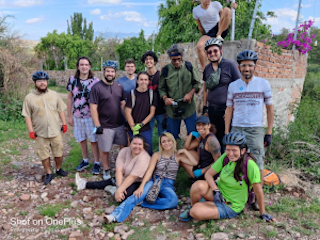Posted on September 27, 2022 by COLFA

They ventured 800 miles south to the Mesa Central of Mexico for three weeks in the (cool) highlands of Mexico, relatively rarely visited by students, led by their geography professors, Drs. Richard Jones and Miguel de Oliver. The theme of the course was “The Spanish-Amerindian Interface,” and the students experienced this interface at every turn in a mestizo country forged from conflict, where in 1521 “Tlatelolco fell into the hands of Hernan Cortes. It was neither a triumph or a defeat: it was the painful birth of the meztizo nation that is Mexico today.” (from a plaque in the Plaza of the Three Cultures, Mexico City).
In Guanajuato, students visited the Alhondiga, a granary, where in 1810 the Spanish elite sought refuge from the army of the priest Miguel Hidalgo, the most famous of Mexico’s heroes---before the door was breached and the gachupines were massacred in the first battle for Mexican independence. They also saw a collection of art produced by the most famous of Mexican muralists, Diego Rivera, at his birthplace in Guanajuato. Rivera is known for his political art depicting the struggles of peasants and Indians against the Spanish hierarchy of church and state and foreign domination, and his belief in socialism as the correct ethical future for Mexico. During their week in Guanajuato the students also had lectures from University of Guanajuato professors on water problems and the impact of tourism on the city; learned firsthand from other professors about the history of mining and the hacienda system; and enthusiastically bicycled into the adjacent highlands, followed by their professors at a slightly more labored pace.
In San Miguel de Allende, students trekked through the Canada de la Virgen to a sacred Otomi hilltop ceremonial center that was a pilgrimage site and center of learning more than a thousand years ago. They also toured Via Organica, an organic farm engaged in sustainable practices such as open grazing, silage produced from cactus, worm composting, water capture, intercropping, and other traditional techniques.
In Puebla, there was a daylong excursion to Cholula and the volcano Popocatepl, a volcano that is currently active. Cholula is notable for its pyramid, in volume the largest in the world, where the Cholulans were conquered in a bloody massacre in 1521 and a church built atop the pyramid---a major reason why it is 95% unrestored to this day. We then drove to the 12,000 foot level on the volcano, the taking-off point from which Charlie Galindo (our guide) and his students from the Autonomous Popular Univ. of Puebla release their drones and balloons to measure temperature and gaseous emissions from the volcano in order to predict future eruptions. Retrieving the devices from villagers---that was another story… Our last day in Puebla was marked by a visit to a migrant town, Preciosita, where we heard the harrowing experiences of migrants, followed by a piñata fiesta with the kids of the community.
Mexico City was our destination for a final five days---the great metropolis of 20 million residents, with colossal environmental challenges and extraordinary beauty and culture and history. There was a walk up to a landmark of recent Mexican post-colonial history---Chapultepec Castle, the residence of Maxmillian and Carlotta, and later Porfirio Diaz; and experiences in contemporary history---Diego Rivera’s studio, and a lecture at the Colegio de Mexico by geography professor Boris Graizbord about Mexico City’s unbounded sprawl and water shortages (but it did not escape the students that Mexico City’s public green public spaces surpassed those of San Antonio, Houston, or Austin). But mostly Mexico City was about Mexico’s ancient cultures. At Teotihuacan, arguably the largest city in the world in 700 AD, they learned about the sophisticated architecture and family life in the residential compounds. At the Templo Mayor, located adjacent to and below the Cathedral on the Zocalo, they relived the archaeological discoveries as the hidden Aztec city slowly emerged from 1790 onwards. At the Museo de Anthropologia, a world-class museum, they braved a downpour as they viewed the resplendent ancient regional cultures---the Mexica, Maya, etc.---and the lesser known cultures of western Mexico. The final day in Mexico City culminated at Xochimilco on a lancha powered by a boatman with a pole---an area simultaneously a historic Aztec garden; a modern source of food for the city; a wildlife preserve; a water reservoir; and a major tourist attraction. As the afternoon waned and the Coronas took effect (21 and older), pointers from the guide were lost among marimba serenades &singing. No one fell into the canal.

